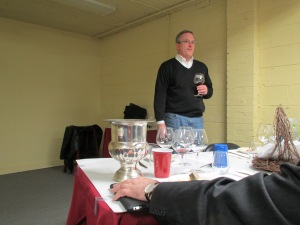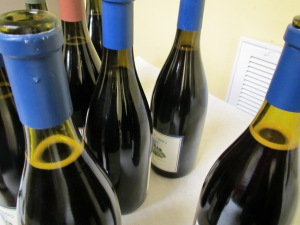Last Thursday the DC area was graced by two wine legends from across the pond. Bartholomew Broadbent came to Chain Bridge Cellars for a tasting of Port and historic Madeira, and Jancis Robinson gave a talk at the Smithsonian in support of her new book on American wine.
At our in-store class on Port and Madeira with Bartholomew Broadbent, dessert-friendly nibbles like bleu cheese and chocolate-covered dried apricots (available in our gourmet food section, and very hard to stop eating!) were served, along with D’Artagnan’s mousse truffee and Cowgirl Creamery’s Wagon Wheel cheese.
The Port was delicious with the bleu cheese and chocolates, and everyone was surprised at how delicious the very reasonably priced Late Bottled Vintage Port was. Bartholomew Broadbent, son of eminent wine writer and Master of Wine Michael Broadbent and head of Broadbent Selections, an import company that specializes in Port and Madeira, explained his theory that Port and Madeira started to fall out of favor when California wines became so intensely alcoholic. No one wanted that last glass after dinner anymore! Anyone who’s tasted a really ripe Napa Valley Cabernet or a Zin from Lodi should agree that there’s probably some truth to this.
As delicious as the Ports were, the Madeiras really shined with both the sweet and savory snacks. Though a historic 1978 bottling was served, the wine of the night for most participants was the 1996 Colheita, with its savory, caramelly depth. Aside from its food-friendliness, Madeira also basically never goes bad, even after the bottle is opened, so it’s the perfect thing to open for a small gathering or just yourself – no need for guilt over not finishing the bottle!
Meanwhile, at the Smithsonian’s Natural History Museum, our own Dave McIntyre, wine columnist for the Washington Post, sat down to interview wine writer and critic Jancis Robinson. Ms. Robinson stopped at the Smithsonian as part of her tour supporting American Wine: the Ultimate Companion, her new book co-written with Linda Murphy on the exploding American wine industry.
What was most striking about the interview and question-and-answer session that followed, was how, well, genuinely nice she seemed. For someone of her stature and level of knowledge – this woman has written some serious tomes – she comes across as so open and relaxed about wine. She’s inclusive and fun and not a snob. As the first person outside the wine trade to become a Master of Wine at a time when the British wine establishment was, shall we say, traditional, this really speaks to her genuine nature and sense of humor.
Despite this background, she’s written a completely earnest, enthusiastic book celebrating American wine. She thinks Norton, a native American grape variety, makes “really nice” wines, and thinks that Virginia Bordeaux-style blends should be included on a short list of classic American wine styles, something that many Virginia residents themselves would be hesitant to assert. She is proof of the value of keeping an open mind when it comes to wine. Riesling from Michigan? Texan wine? Bring it on, and keep it coming, was her message. We’ll try, Jancis.
















